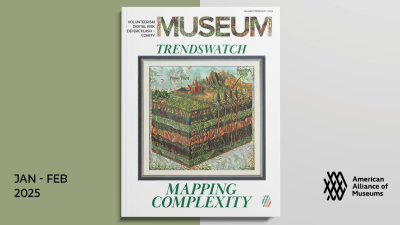
One national trend I’ve been tracking is the recent rise in people experiencing homelessness or housing insecurity. On any given night over a half million people in the US are coping with homelessness. Over a third of these people are unsheltered—living on the streets with no access to emergency shelters or transitional housing. Regular readers will know that I believe for any need we experience in society, there are museums that can and do step up to help. Case in point: on a recent trip to Dallas, I met with Alan Govenar, who founded The Museum of Street Culture, one of several new museums giving voice, and agency, to people without access to secure and affordable housing. Today on the Blog, Alan shares a bit about the Museum and its launch.
–Elizabeth Merritt, VP Strategic Foresight and Founding Director, Center for the Future of Museums, American Alliance of Museums.
The Museum of Street Culture validates the history and everyday experience of people in public places through diverse forms of art, education, and new ideas, activating social change and building community. By involving artists, arts professionals, health and human service specialists, individuals and families experiencing homelessness, and the public at large in an unprecedented dialogue, it dignifies what is often seen as unimportant and irrelevant and breaks down stereotypes of about the ever-changing role of museums in the world today.
I proposed the idea for the museum in 2012 after volunteers from the First Presbyterian Church of Dallas invited me to help them organize exhibits and public programs related to the film and music history of 508 Park, a building (opened in 1930 as the Warner Brothers Exchange Building) they had acquired to expand the services and outreach of The Stewpot, which offers a safe haven for homeless and at-risk individuals, providing resources for basic survival needs, as well as opportunities to start a new life.
We opened the museum five years later with an exhibition called Looking for Home, presenting a yearlong focus on the work of Mary Ellen Mark and her documentation of the harsh realities of street life through her photographs of the life of Erin Blackwell, a.k.a. Tiny, in Seattle, Washington, beginning in 1983 and continuing to 2015. I curated the exhibition with Martin Bell, Meredith Lue and Julia Bezgin from the Mary Ellen Mark Foundation. Studio Adrien Gardère designed the exhibition, which included the installation of Mary Ellen Mark’s photographs printed in different formats and sizes inside The Stewpot and on its exterior walls, as well as exterior walls of the 508 Park building.
In conjunction with the exhibition, Danielle Naylor, Museum of Street Culture education coordinator, and I implemented a broad range of programming, including a docent program; educational outreach in partnership with The Stewpot’s Saturday Kids’ Club, Junior and Venturing Crews, and The Stewpot Art Program; the screening of Martin Bell’s documentary film “Streetwise;” and a public dialogue series that featured artists and curators in conversation with health and human service specialists.
The Museum of Street Culture Overview from Documentary Arts on Vimeo.
Docent Program
Working with members of The Stewpot staff, we recruited clients of The Stewpot interested in becoming museum docents. As docents, they were paid $10/hour to learn about the Mary Ellen Mark photographs and to present tours of the exhibition inside and outside The Stewpot. Tours were offered three days a week, from noon to 1PM, when the Stewpot was closed for lunch. (We did not want to impose on the privacy of Stewpot clients and to interfere with the services provided to them.) (Access a video about the program here.)
In each training session, the docents explored the meaning and context of the photographs and learned strategies for engaging visitors. During practice tours, they interacted with each other and with staff from the museum and The Stewpot. One docent, Bill, compared problems in current day Dallas with the reality that Mark documented in Seattle and talked about how the photographs made in the 1980s were still illuminating today. Vickie spoke about her days as a young adult and how she wished someone like Mary Ellen Mark would have been around to help her; instead, she credited being arrested for her sobriety. Sam engaged visitors by posing questions that helped them immerse into the vulnerability and humanity of the people in the photographs. Peter hinted at how his parents acted very similar to Tiny’s mother. Misty asked visitors (in both English and Spanish) to interpret the works out loud leading to conversations about the current social and political climate. Carmelo focused on the emotions of the subjects in the photographs to help visitors feel Tiny’s struggle.
More than 400 visitors to the museum have participated in docent tours, from as far away as Canada. One person, who walked in believing the stereotypes about people who are homeless, broke down in tears after the tour when they realized their preconceptions were so far from the reality of people who are experiencing homelessness. Most visitors say that the exhibition enlarged their understanding of homelessness and were grateful for the experience. Visitors also acknowledged the sincerity of the docents, who shared their stories and intensified the visitors’ experience, connecting the past with the present.
Education Programs
We developed two educational programs to broaden the reach of Looking for Home. Picturing Homelessness (video) challenged children, grades 1-5, to explore stereotypes and needs related to family, shelter, food, and pets. Students were asked to consider:
- What would your home look like if you didn’t have a house?
- What does it mean to be homeless?
- How do you think someone becomes homeless?
- What emotions do you think someone who becomes homeless feels?
- How can we help effect change to end homelessness?
- Why should we care?
These questions challenged the children to dispel stereotypes and negativity. Then the children split into small groups and were encouraged to express their answers through collaborative drawings. Photography and Social Justice (video) asked students ages 11-16 to explore the neighborhood surrounding The Stewpot and the First Presbyterian Church of Dallas. Sharing three point-and-shoot cameras, the teens documented what they saw on the street, identified the indicators of homelessness, and discussed how photographs can make people more aware of issues related to social justice.
These programs equipped students with the language to talk about issues that may hit close to home for them. They had a better grasp of the reality of homelessness and the ongoing need to break down stereotypes in the pursuit of social justice and advocacy.
Sharing our Work
The Museum of Street Culture continues to evolve. We are currently developing our next exhibition. Street Culture, 1751–Present, which will feature more than 100 pieces from our permanent collection, including engravings, photographs, graffiti, and ephemera, beginning with William Hogarth and ending with Os Gemeos and other contemporary street artists. Both this and our inaugural exhibition are available as loans, inquiries welcome. Free brochures and learning resources can be downloaded from our website: www.museumofstreetculture.org.
Credits and thanks:
The Museum of Street Culture is supported in part by Encore Park Dallas, Documentary Arts, Florence Gould Foundation, The Stewpot, and First Presbyterian Church of Dallas. The Kaleta A. Doolin Foundation funded the printing of the Mary Ellen Mark photographs. Additional funding for educational outreach was provided by The Sister Fund, The Jim and Jill Cochran Foundation, and The Restoration Fund of Communities Foundation of Texas.
Skip over related stories to continue reading article







Comments